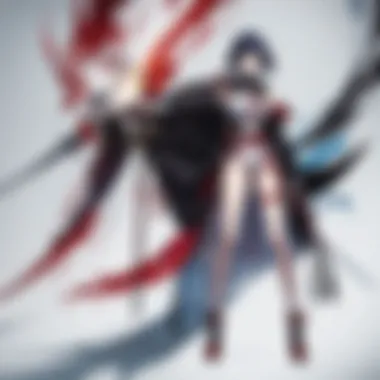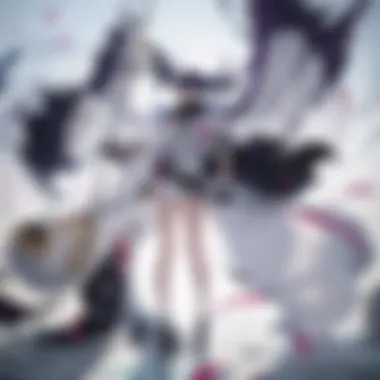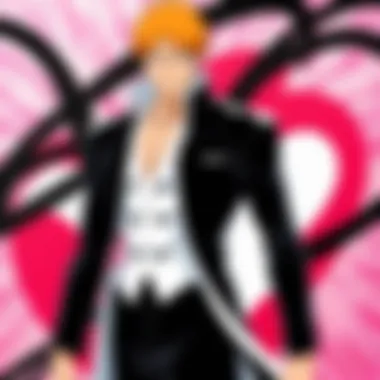Exploring the Cultural Significance of Bleach in Anime


Intro
In the realm of anime, few titles have left as indelible a mark as Bleach. Launched in 2001, this series quickly captured the attention of both fans and critics alike. Its unique blend of action, fantasy, and deep character exploration sets it apart from its contemporaries. As we delve into Bleach, we will uncover not only its riveting narrative and vibrant characters but also its broader impact on popular culture. This exploration aims to enrich the understanding of Bleach as a significant work within the anime genre.
Series Overview
Synopsis and Premise
Bleach follows the story of Ichigo Kurosaki, a teenager with the ability to see ghosts. His life takes an unexpected turn when he encounters Rukia Kuchiki, a Soul Reaper tasked with defeating malevolent spirits known as Hollows. After Rukia is injured during a confrontation, Ichigo assumes her role, gaining supernatural powers. This premise establishes a dual narrative framework, wherein Ichigo navigates the complexities of the human world while battling spiritual threats.
Notable Characters
The richness of Bleach lies in its diverse cast of characters, each contributing to the series’s depth. Key figures include:
- Ichigo Kurosaki: A reluctant hero, whose growth is central to the narrative.
- Rukia Kuchiki: The Soul Reaper who ignites Ichigo's journey.
- Renji Abarai: A fellow Soul Reaper and childhood friend of Rukia, who adds layers to the storyline.
- Sosuke Aizen: The primary antagonist whose complex motivations prompt profound thematic explorations.
These characters, among many others, drive the narrative and engage audiences through intertwined arcs and relationships.
Themes and Motifs
Major Themes Explored
Bleach delves into several significant themes. Among them, the struggle between good and evil is predominant. The series often examines morality and the gray areas between these binary concepts, prompting viewers to question motives and decisions.
Another essential theme is the concept of self-discovery. Characters undertake personal journeys, revealing how past experiences shape their identities. The exploration of friendship and loyalty underpins many interactions, showcasing how these connections influence actions.
Symbolism in Storytelling
Symbolism plays an important role in Bleach. The Soul Reapers represent the equilibrium between life and death, an idea that resonates throughout the story. The use of weapons like zanpakuto illustrates personal identity, as each weapon reflects its wielder's spirit and growth. The connection between the living world and the Soul Society also reinforces the themes of balance and consequence.
Artistic Style and Animation
Visual Aesthetics and Design
The aesthetic appeal of Bleach is undeniable. Its character designs are distinctive, often featuring unique hairstyles and fashion that reflect personality traits. The environments vary from urban landscapes to ethereal realms, which add to the immersive quality of the series.
Animation Techniques and Trends
The animation in Bleach showcases fluid action sequences and dynamic fight scenes. Techniques such as limited animation are used effectively, creating a sense of speed during battles. Moreover, the series has embraced various stylistic trends, paralleling developments within the anime industry.
"In many respects, Bleach served as a bridge. It not only entertained but allowed deeper discussions on life, death, and morality."
As we continue our exploration of Bleach, we will further analyze its cultural significance and enduring legacy within the anime community.
Intro to Bleach
The significance of the anime series 'Bleach' cannot be overstated. From its debut, it carved a niche in the landscape of anime culture. Understanding the series begins with its intricate origins and development over the years. This article aims to highlight how 'Bleach' intertwines with broader themes in anime and its narrative depth.
Origins of the Series
'Bleach' was created by Tite Kubo and initially serialized in Shueisha's Weekly Shōnen Jump starting in 2001. The creation of this series was influenced by various cultural and personal factors. Kubo’s passion for manga began in his youth, inspired by multiple works he admired. His artistic style and storytelling were shaped largely by the limitations he faced early in his career. This history is crucial as it contributes to the unique narrative and visual style found in 'Bleach'.
The initial reception of 'Bleach' was overwhelmingly positive. Its fresh take on shōnen tropes, combined with dynamic character design, helped to establish a substantial fan base. As readership and viewership grew, 'Bleach' expanded beyond manga into an anime adaptation produced by Studio Pierrot, first airing in 2004. This willingness to adapt and evolve allowed 'Bleach' to reach a global audience, securing its place in anime history.


Premise and Setting
The premise of 'Bleach' revolves around Ichigo Kurosaki, a teenager who gains the ability to see ghosts. This unique gift thrusts him into the role of a Soul Reaper, tasked with defending the human world from malevolent spirits known as Hollows. The setting blends elements of modern Japan with a supernatural realm, known as Soul Society, where the Soul Reapers operate. This juxtaposition of reality and fantasy sets the stage for exploring profound questions about life, death, and existence.
The world-building in 'Bleach' is meticulous. Different districts of Soul Society display a social hierarchy that echoes aspects of real-world cultures. Each character's journey is deeply interconnected with the lore, enhancing the viewer's immersion in this universe. The complexity of the setting and its characters serves as a foundation for the themes that resonate throughout the series.
In summary, the introduction to 'Bleach' sets a necessary tone for understanding its cultural impact. By examining the origins and premise, readers can appreciate its significance beyond typical anime narratives.
Main Characters and Their Development
The characters in Bleach are pivotal to its narrative structure and thematic depth. By delving into the journeys of the main characters, we can understand their motivations, conflicts, and how they shape the overall story. Each character embodies distinct traits and complexities that resonate with the audience, allowing for a rich exploration of personal growth and moral dilemmas. This section will detail how Ichigo Kurosaki, Rukia Kuchiki, and the supporting cast contribute to the series’ enduring relevance in the anime community.
Ichigo Kurosaki: The Reluctant Hero
Ichigo Kurosaki serves as the central figure of Bleach. A high school student endowed with the ability to see ghosts, Ichigo’s journey begins when he encounters Rukia Kuchiki, who inadvertently gives him her powers as a Soul Reaper. This act thrusts him into a world filled with spirits, conflicts, and moral questions.
Ichigo’s reluctance to accept his role as a hero reflects the struggle many individuals face in overcoming their fears and insecurities. Throughout the series, his character evolves from a typical teenager battling external monsters to a formidable fighter confronting internal demons. His battles often symbolize the challenges of growing up and navigating complex emotions.
His arc allows for a relatable portrayal of struggle and self-discovery, making him a compelling character for fans to connect with.
Rukia Kuchiki: The Catalyst
Rukia Kuchiki is integral to the development of the plot and Ichigo’s character. As a disciplined Soul Reaper from the noble Kuchiki family, her initial introduction to Ichigo disrupts the balance of both their worlds. Rukia's serious demeanor contrasts sharply with Ichigo's brashness, creating a dynamic relationship that drives the narrative.
Rukia’s character embodies the theme of sacrifice and the weight of responsibility. Her decision to bestow her powers onto Ichigo invites not only conflict but also a journey of mutual growth. As the story unfolds, Rukia grapples with her own limitations and learns from Ichigo’s approach to heroism, creating a reciprocal journey of empowerment.
This duality represents how bonds can influence personal growth and highlight the significance of collaboration in facing adversities.
Supporting Cast: Depth and Complexity
The supporting cast in Bleach enriches the narrative through their diverse backgrounds and motivations. Characters such as Uryu Ishida, Orihime Inoue, and Renji Yakuza offer unique perspectives that complement Ichigo and Rukia’s storylines.
Each character has their struggles, triumphs, and relationships that masterfully interweave with the main plot. For instance, Uryu, as a Quincy, introduces a contrasting philosophy on dealing with hollows and spirits, challenging Ichigo to consider alternative viewpoints. Orihime's unwavering support and Renji's loyalty further illustrate the themes of friendship and camaraderie throughout the series.
"The characters in Bleach showcase a broad spectrum of human emotion and ethical conflicts, adding layers to the overall story."
Understanding the supporting characters is essential as they embody the series’ overarching themes of sacrifice, friendship, and the quest for identity. Their complexity enriches the viewing experience and serves as a reminder of the importance of community in both personal growth and overarching narrative progress.
Narrative Structure and Themes
The narrative structure and themes in Bleach serve as a cornerstone for its enduring popularity and cultural significance. The series intricately weaves plots that engage the audience on multiple levels. The story arcs are not merely sequential events; they are profound explorations of complex ideas that resonate within the fabric of anime. Bleach adeptly employs a structure that allows various themes to emerge organically, allowing audiences to reflect on moral dilemmas, the intricacies of relationships, and existential questions surrounding death.
Moral Ambiguity in Bleach
Bleach is renowned for its moral ambiguity. Characters frequently exist in grey moral zones, leaving viewers to ponder their actions and motivations. For instance, Ichigo Kurosaki, the protagonist, often grapples with the burden of heroism versus self-interest. He must confront antagonists who challenge the notion of good and evil. This creates a layer of complexity, as characters such as Sosuke Aizen reveal that intentions can be shrouded in mystery. The question arises: Can one justly condemn actions when motives might be just?
This ambiguous morality enhances the depth of Bleach. It illustrates human fallibility, showcasing how choices can lead to unintended consequences. Viewers are drawn into debates about justice, power, and redemption, often reflecting their interpretations based on personal beliefs. Such themes encourage critical thinking about ethical dilemmas that extend beyond the anime itself.
Friendship and Betrayal
Friendship and betrayal are central themes in Bleach. The relationships between characters demonstrate a spectrum of loyalty and treachery. Ichigo’s bond with his friends symbolizes unwavering support, especially seen in his struggles against formidable foes. Yet, this camaraderie is tested as characters face internal conflicts and external pressures.
Notably, Rukia Kuchiki’s initial betrayal in her interactions with Ichigo presents a poignant exploration of trust. This moment encapsulates the idea that betrayal can be incidental or a consequence of larger forces. The series artfully navigates these themes, showing that friendships can weather storms but also reveal hidden fractures.
This exploration of relationships enriches the narrative. It invites the audience to reflect on their own experiences with trust, loyalty, and the repercussions of betrayal in their lives.


Death and the Afterlife
Death and the afterlife are recurring motifs in Bleach. The series delves into these concepts through its portrayals of soul reapers and the Soul Society. Jidanbo, the gatekeeper, and the various realms inhabited by souls highlight the significance of transition, both physical and spiritual.
By engaging with these themes, Bleach prompts viewers to confront their perceptions of mortality. Death is not depicted as an end; rather, it is portrayed as a transformation. This perspective aligns with many cultural beliefs, making the series resonate across different audiences.
The narrative raises philosophical questions: What comes after death? How do the living relate to those who have passed? Such inquiries can be unsettling but ultimately enrich the overall understanding of life, loss, and legacy.
"In Bleach, death is not just an event but a catalyst for transformation and self-discovery."
As a result, the narrative structure emphasizes themes that are both relatable and profound. Each thematic element, from moral complexity to the exploration of death, underscores Bleach’s cultural importance, revealing its capacity to engage viewers far beyond mere entertainment.
Cultural Impact of Bleach
The cultural impact of Bleach is significant in many respects. It goes beyond just being an anime or manga series; it has shaped communities, influenced other creative works, and established a range of commercial ventures. Through its rich storytelling and complex characters, Bleach encapsulated a specific era of anime that resonated deeply with both Japanese and international audiences. This section will explore how Bleach influenced other works, its reception in the anime community, and its role in merchandising and brand expansion.
Influence on Other Works
Bleach has contributed to a trend in narrative and artistic styles in anime. Many series that followed began to adopt similar themes of moral complexity, intricate world-building, and character-driven plots. Noteworthy examples include Naruto and Fairy Tail, which share elements like the importance of friendship and battles that hinge on emotional stakes.
The innovative use of supernatural abilities in Bleach, as seen with the concept of Zanpakuto, has inspired other creators to explore unique powers and abilities in their storytelling. This led to more varied and visually dynamic fight sequences in subsequent anime series.
Reception Within the Anime Community
The reception of Bleach has varied over the years, but it holds an esteemed place in the hearts of many anime enthusiasts. Upon its initial release, it quickly garnered a loyal fan base. Viewers appreciated the depth of characters and the intricacy of the narrative.
However, as the series progressed, critiques began to emerge regarding pacing and story arcs. Yet, even in these discussions, Bleach remains a topic of passionate conversation among fans and critics alike. Forums like Reddit and fan pages on social media platforms often feature heated debates about the series' themes and character arcs, showing that Bleach's impact has fostered an engaged community.
Merchandising and Brand Expansion
With its rise in popularity, Bleach has expanded into a vast merchandise empire. This includes action figures, clothing, video games, and collectibles. The brand’s reach extends beyond Japan, influencing merchandise sales in Western countries.
The success of Bleach merchandise helped set a precedent for what can be achieved in anime merchandising. Supported by limited edition releases and collaborations with popular brands, Bleach continues to be a lucrative franchise. The combination of its engaging content and robust merchandising strategy illustrates how deeply embedded Bleach is in popular culture.
"The cultural footprint of Bleach in anime is not merely about viewership but about its long-lasting influence and legacy across various creative outlets and fandoms."
In essence, Bleach has emerged as a cornerstone of the anime landscape, shaping not only its genre but also inspiring a generation of content creators and fans. Its cultural significance is underscored by the connections forged within its community and the innovations it spurred within the industry.
Artistry and Animation Techniques
Artistry and animation techniques play a crucial role in distinguishing Bleach from other works in the anime genre. The visual storytelling and animation quality profoundly impact how the narrative and character development are perceived by the audience. Bleach stands out not only for its gripping storytelling but also for the artistry that translates the story into a compelling visual experience.
Visual Style of Bleach
The visual style of Bleach incorporates a variety of artistic techniques that emphasize the mood and themes within the series. The color palette often shifts to match the emotional weight of scenes. Dull tones may dominate moments of despair, while vibrant hues emerge during action sequences. Backgrounds are richly detailed, enhancing the viewer's immersion into the Soul Society and human world. This approach allows fans to connect with the series emotionally.
In terms of character design, Bleach features a distinct style rooted in both traditional Japanese aesthetics and modern influences. The characters are often clothed in elaborate outfits that reflect their personalities and powers. For instance, Ichigo's distinct hair color and signature Soul Reaper uniform indicate his role as a protector. These visual cues provide insights into the characters while maintaining a cohesive artistic theme.
Fight Choreography and Action Sequences
Fight choreography in Bleach is renowned for its fluidity and dynamic nature. Each battle sequence is meticulously crafted to showcase not only the characters' abilities but also their emotional states during conflict. The choreography often incorporates a mix of aerial maneuvers, swordplay, and supernatural abilities, making these scenes visually captivating.
More than just spectacle, these action sequences carry narrative weight. They often serve as turning points in character arcs or highlight moral dilemmas confronting the characters. For example, when Ichigo battles opponents from the Arrancar series, the intensity and complexity of the fights mirror Ichigo’s internal struggles. This attention to detail reinforces the show's depth and elevates the stakes in each confrontation.


Character Design Aesthetics
The character design aesthetics of Bleach are not merely about appealing visuals; they also convey significant information about the characters. Each design element allows for a deeper understanding of personality traits and motivations. Rukia's petite frame and meticulous clothing illustrate her disciplined nature, while characters like Kenpachi Zaraki are designed to visually represent their ferocity and strength.
The use of symbolic elements in character designs is also notable. For instance, Yoruichi Shihouin’s black skin and striking hair symbolize her agility and power. As a Shinigami with a rich backstory, her design plays into the deeper themes of identity and legacy central to Bleach.
"The visual language of Bleach not only captivates but also enhances narrative engagement, providing depth that resonates with viewers."
Critical Reception and Legacy
The examination of critical reception and legacy of Bleach is essential to understand its place in the anime landscape. This series not only shaped its followers but also influenced the creation and evolution of future anime. Its narrative complexity, character developments, and cultural themes resonated with both fans and critics. These factors contribute to its sustained interest and analysis even years after its initial release.
Reception Over Time
From its debut in 2004, Bleach garnered attention for its unique blend of action, supernatural elements, and character-driven stories. The initial reception was positive, with audiences captivated by the compelling world-building and dynamic characters. However, as the series progressed, the reception became more mixed. Critics pointed out pacing issues and inconsistencies in storytelling, especially in the later arcs.
- Initial Acclaim: Critics praised the art style and intense battles.
- Subsequent Critiques: Some felt character arcs became repetitive or lacked depth.
- Fan Loyalty: Despite criticisms, a dedicated fan base continued to support the series.
This shift in perception highlights how long-running series can face different evaluations at different points in their narratives. Still, Bleach's ability to adapt and maintain a loyal viewership underlines its significant impact.
Awards and Recognitions
Bleach has received various awards and nominations that validate its contributions to the anime genre. These accolades exemplify both fan appreciation and critical recognition. Key awards include:
- Shogakukan Manga Award for Best Shōnen Manga
- Tokyo Anime Award highlights for outstanding Distributive Titles
- Recognition at various anime conventions, showcasing its cultural importance
These honors reflect not just the quality of the anime but its influence on pop culture. Notably, winning awards establishes Bleach as a noteworthy reference point for discussions surrounding modern anime.
Continued Relevance in Popular Culture
Bleach's legacy remains prominent within popular culture. Even years after its conclusion, it influences new series and media formats. Collectively, characters like Ichigo and Rukia have become iconic figures, representing the blend of action and emotional depth seen in contemporary anime. Moreover,
- Merchandise: Ongoing production of figures, clothing, and collectibles
- Spin-offs: Series like Bleach: Thousand-Year Blood War continue storytelling
- Fan Works: Numerous fan art and fanfiction contribute to its ongoing presence online
*"The legacy of Bleach is a testament to its impact on storytelling and character exploration in anime. It continues to shape narratives today, proving its relevance long after the credits roll."
In summary, analyzing Bleach's critical reception and legacy provides insights into its enduring popularity. The series navigates challenges and evolves with its audience while maintaining roots in its original appeal. Understanding its journey helps fans and scholars appreciate the broader implications of anime as a cultural phenomenon.
Closure
The conclusion of this article emphasizes key takeaways about the cultural significance of Bleach in the anime landscape. This series is not merely entertainment; it holds various lessons and themes relevant to many viewers. By summarizing its narrative depth, character arcs, and stylistic elements, one can see how Bleach connects with its audience and resonates on multiple levels.
Several specific elements stand out:
- Character Complexity: The character development of Ichigo Kurosaki and the supporting cast leaves a lasting impact. Their struggles, growth, and relationships form the core of the series.
- Thematic Depth: Themes like moral ambiguity, friendship, and the concept of life and death present in Bleach elevate it beyond a typical shonen narrative.
- Cultural Influence: The far-reaching impact on both the anime community and popular culture reflects how Bleach has shaped perceptions of anime both in Japan and internationally.
In understanding these benefits, viewers can appreciate not just the story but its implications and influence over time. Consideration of Bleach goes beyond its surface value as an anime; it serves as a cultural artifact deserving of detailed examination.
Summarizing Key Insights
Through an analysis of Bleach, several insights emerge:
- The series showcases a complex narrative structure that conveys deep philosophical questions. This makes it not only entertaining but also thought-provoking.
- The intricate relationships among characters highlight social themes that resonate with the audience's real-life experiences.
- Bleach has left a footprint in the anime genre, serving as a precursor to many subsequent series, demonstrating its role as a cultural cornerstone.
Bleach's Place in Anime History
Bleach occupies a significant role in anime history due to its unique contributions. Several points illustrate this:
- Pioneering Narrative Techniques: The storytelling approach that Bleach employed has influenced modern anime in how themes of identity and personal growth are presented.
- Cultural Phenomenon: The series' popularity helped pave the way for other titles in the genre, allowing for a broader acceptance of anime in mainstream culture.
- Awards and Recognitions: Bleach has received numerous accolades that speak to its quality and artistic merit, further solidifying its status as a pivotal work.
In summary, Bleach stands as an essential part of anime history, embodying a blend of engaging storytelling and cultural significance that continues to be felt even today. It provides valuable references for both creators and consumers within the anime community.



